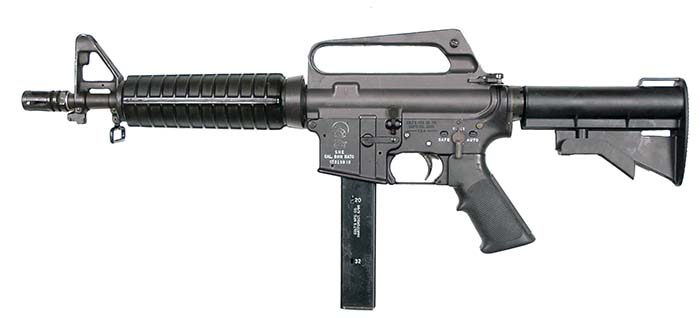By Frank Iannamico
The AR-15 rifle was originally conceived by the Armalite Division of the Fairchild Aircraft Corporation by Eugene Stoner, Robert Fremont and James Sullivan. The AR-15 followed an earlier Armalite rifle, the AR-10 chambered for the 7.62×51 cartridge. Both the AR-10 and AR-15 were unique for military rifles of the day, using a lot of aluminum and plastic in their construction. The AR-15 was chambered for a high-velocity .22 caliber round. The AR-15’s space-age appearance, materials, and small caliber made it unappealing to most military establishments, who resisted change. Armalite, discouraged by the lack of sales, decided to sell the rights to the AR-15 design to Colt’s Patent Firearms during 1959. Colt salesman began a worldwide campaign to aggressively market the weapon. In 1961, a substantial number of the AR-15 rifles were requested by U.S. Air Force to replace their aging M1 carbines, but the request was denied. During 1962, a small number of AR-15 rifles were shipped to Vietnam to arm U.S. Special Forces advisors operating there. Reports from the field praised the AR-15’s performance. In 1963 Secretary Robert McNamara ordered M14 production to be terminated and approved an order for a substantial number of AR-15 rifles for the U.S. Army and the Air Force. The AR-15 was adopted as the Rifle, Caliber 5.56mm M16.
The AR-15/M16 rifle was adopted to replace the 7.62 M14 which was proving ill suited for the type of combat then being encountered in Vietnam. The M16 had several advantages over the M14, it was lighter, far more manageable in full-auto operation and the basic ammunition load was nearly double for the same weight. However, the early M16 rifles proved to be quite problematic, the weapon was subject to jamming and malfunctioning during encounters with the enemy, often resulting in the loss of American lives. The problems were found to be a combination of things: lack of proper cleaning, a change in the cartridge propellant, and barrels lacking chromium lining, which were rapidly corroding in the humid climate. Addressing the problems resulted in the adoption of much- improved weapon, the M16A1, in 1967. At the time the problems were occurring it would be very difficult to convince anyone that the M16 would remain in service longer than any other U.S. military rifle, still being issued in 2016 with no viable replacement for the immediate future.
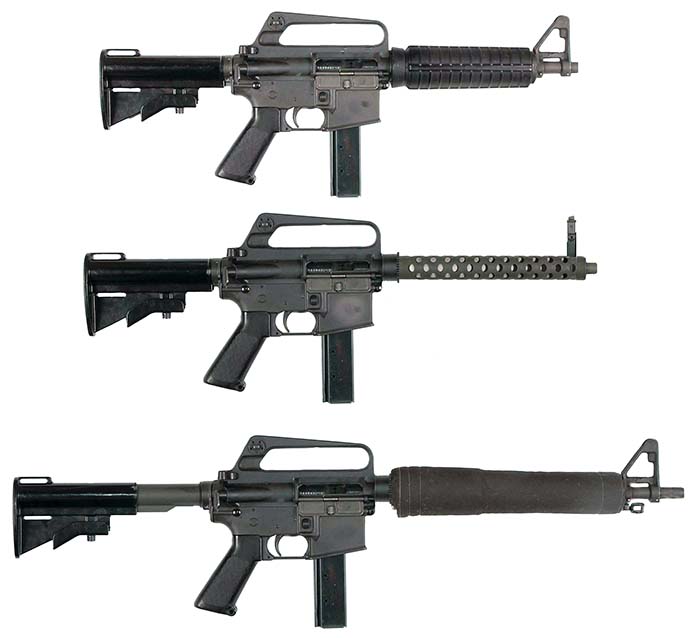
In 1963 Colt introduced a semi-automatic civilian version of the M16 using the rifle’s original name AR-15.
The civilian AR-15 differed slightly from its military counterpart. To satisfy the ATF requirements as to not be “readily converted to full-automatic function”, the hammer, trigger and bolt carrier were designed differently and there was no provision for installing an M16 trip sear. The front pin hole in the early AR-15s lower and upper receivers was larger so that an M16 upper could not be installed. The upper receiver was also designed so that it would interfere with an M16 auto sear in the lower receiver.
Select-fire 5.56mm M16 rifles were also made available for law enforcement sales. Although pistol caliber submachine guns had been deemed largely obsolete for military issue, there was an increasing law enforcement requirement for automatic weapons to match the firepower of a growing number of violent drug dealers. Assault rifles were considered too dangerous for use in a civilian environment, because of a fear of collateral damage by over penetration by their high-velocity rounds. The requirement for a law enforcement submachine gun was being met by purchasing 9mm Israeli UZI s. The UZI was a very reliable weapon, proven in military conflicts, but its big disadvantage was its open-bolt operation, which made precision semiautomatic fire difficult. Heckler and Koch soon entered the law enforcement arena with their excellent MP5 9mm submachine gun that was light, ergonomic, very controllable, and fired from a closed bolt, making it capable of quite accurate semiautomatic fire. The MP5 became very popular with law enforcement agencies around the globe. The MP5 was adopted in the U.S. by a large number of SWAT teams, the FBI, Secret Service, Navy SEALs and the ATF.
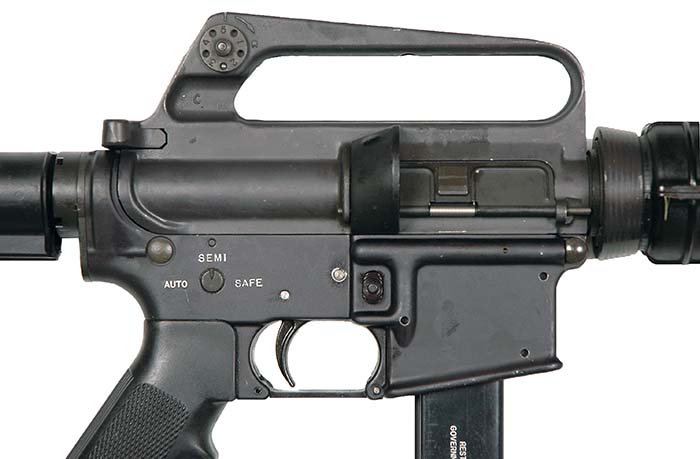
Colt, eager to increase law enforcement sales, began to develop a submachine gun to compete with the MP5.
Instead of designing a new weapon, Colt decided to create one using the existing M16 platform. However, Colt wasn’t the first to see the potential of the M16 as a 9mm submachine gun. Back in the 1970s Max Atchisson, a well known inventor and engineer, had an idea for a pistol caliber M16. His conversion of the weapon to 9mm was based on Colt’s compact XM177E1, a short-barrel version of the M16A1 with a telescoping aluminum buttstock. Atchisson assembled three different prototype upper receivers chambered for 9mm Parabellum. Two were open-bolt operated. One with a perforated metal barrel shroud from an M2 aircraft Browning machine gun, one with a standard M16 carbine handguard, and a closed-bolt silenced model using a .45 caliber MAC-10 suppressor converted to a wipeless design. The suppressed 9mm/M16 used a ported barrel to bleed off a calculated amount of gas, reducing the velocity of standard 9mm ammunition to subsonic velocity. Atchison’s 9mm M16 conversions used 9mm magazines originally designed for the Marlin UD-42 and Beretta submachine gun. The idea never progressed past the experimental stage. Atchison’s other M16 projects included a .22 caliber rimfire conversion kit for the M16, which was originally marketed by the Military Armament Corporation. It is unknown if the Colt factory knew of Atchison’s early work, when they embarked on a program to design their 9mm M16 rifle, during the 1980s.
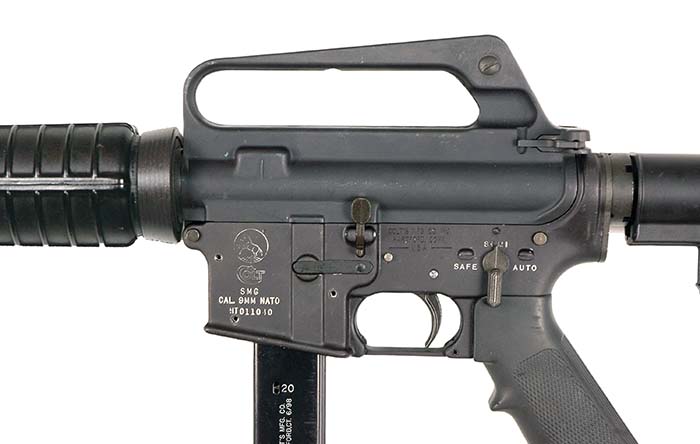
Colt management felt that a 9mm version of the M16 would be attractive to the law enforcement community, who at the time preferred to provide American made weapons, equipment and vehicles to their officers. In addition, many police officers who were military veterans were already well trained in the operation, maintenance, and applying immediate action to clear malfunctions in M16 rifles.
Colt engineer Henry Tatro was assigned the project of designing a 9mm submachine gun out of the 5.56mm M16. The 9x19mm NATO cartridge generates far less chamber pressure than a 5.56mm round thus eliminating the need of the M16’s gas system and rotating bolt. Instead, the 9mm weapon was designed using an unlocked, blowback system. A weight was added to the bolt carrier to keep the bolt closed until the pressure was reduced to a safe level, before the bolt started rearward to first extract and then eject the spent case. The bolt’s rearward motion was slowed by a heavy buffer, before being propelled forward by the recoil spring and a fresh round fed and chambered. The steel weight pinned in the bolt also kept the full-auto cyclic rate to a manageable level. To prevent slam-fires the firing pin is fitted with a spring. Other problems encountered on early models was that the trigger and hammer pins were breaking. To solve the problem Colt began to use hammer and trigger pins made of stainless steel. Another problem was excessive gas coming from the large ejection port, caused by the weapon’s blow-back design. This was especially annoying for left-handed shooters. The problem was addressed by shortening the ejection port by adding a hard polymer gas deflector block at the back of the port opening, and removing a portion of the port cover to accommodate it. The next area that needed to be addressed was the adaptation of a 9mm magazine into the wide M16 magazine well. For this problem magazine well inserts were used. The rear insert housed the ejector, while the feed ramp was on the front insert. The sides of the inserts were drilled to contain small springs to keep the inserts snug in the magazine well. The inserts were secured by three roll pins, two in the front insert and one in the rear one. The original magazines chosen were the proven Israeli double-stack, double-feed design. The magazines were redesigned to hold the bolt rearward when the magazine was emptied. The bolt catch had to be lengthened to prevent breakage when stopping the heavy 9mm bolt. The Colt magazines were produced in 20 and 32 round capacities. Original manufacture magazines can be identified by the Colt logo on the bottom of the floorplate.
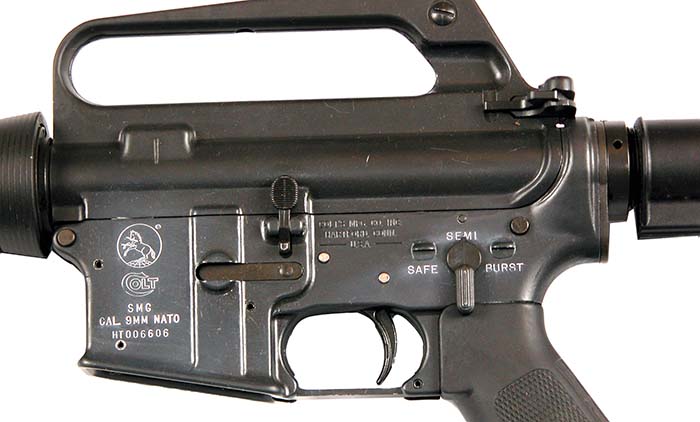
Early series production models used the A1 style upper receiver with the integral carry handle, but lacked the forward assist feature. The windage adjustable rear L sight has two leafs: one with the larger aperture is marked 50M for 50 meters, the other leaf has a smaller aperture and is for 50-100 meter ranges. Later models featured a flat-top receiver with a modular rail for mounting modern optics and accessories. A new one-piece magazine adapter is used, but still pinned in place. The lower receivers are roll marked Colt SMG, Cal 9mm NATO followed by the serial number with an HT prefix, reportedly the initials of the lead project engineer Henry Tatro.
Model R0634
The R0634 is similar to the standard Model 635 with a 10.5-inch barrel described below, except it is semiautomatic-only. There is a “filler” pin in the hole normally used for the auto-sear pin on select-fire models. The Model R0634 can be easily converted to select-fire if desired, by installing an auto-sear assembly. The weapon is intended only for law enforcement use.
Model R0635 and R0639
Introduced in 1985, the R0635 is the most common model of the 9mm M16. The standard Model 9mm M16 is fitted with a 10.5-inch long 1/10 twist, chromium-lined barrel. The muzzle end is threaded differently (1/2-36) so that a 5.56 muzzle brake (with a small diameter opening) cannot be accidently installed on it. The weapon can fire semiautomatic or full automatic, the cyclic rate is approximately 800-1000 rounds per minute. The telescoping adjustable buttstock is made from a composite plastic. The R0639 model is similar, except it has a 3-round burst feature.
Model R0635SD
This variation is based on the R0635 model, but features an integral sound suppressor, which is concealed by modified M16A2 handguards. The suppressor was manufactured by Knight’s Armament.
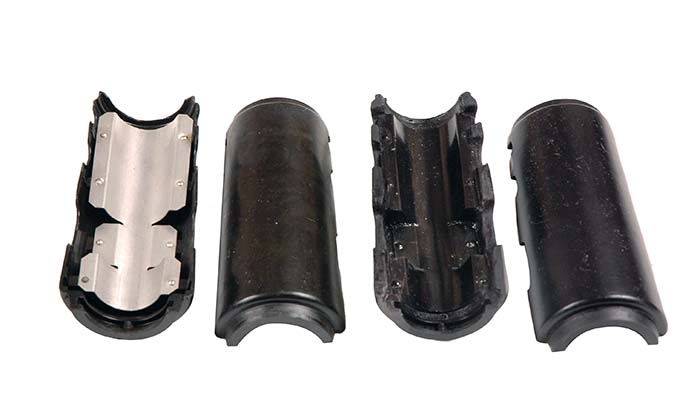
The Colt “Briefcase Gun” or “DOE” Model R0633 and R0633HB
Colt’s Model R0633 9mm M16 submachine gun, better known as the Department of Energy or DOE submachine gun is a rare variation. The DOE prototypes were assembled from standard M16 components, including one with an M16A2 flat-top upper receiver with a removable carry handle and forward assist. The prototype had a rear pop-up sight to align with the folding front sight. The weapon also had shortened carbine round handguards. The 7-inch barrel had an M16 birdcage flash-hider.
Early series production models used the A1 style upper receiver with the integral carry handle. The unique feature of this model is its 7-inch barrel, with a flip-up front sight. The buttstock is the telescoping model used on other Colt submachine guns and carbines. The submachine was designed for concealment or carry in small or confined spaces such as inside a vehicle, where normally a handgun would be carried, but more firepower was required, a submachine gun being far more effective than a handgun in an ambush situation. A number of the “DOE” short barreled upper receivers were available on the market a few years ago, at a premium price. The uppers most likely were taken off of former government weapons that were removed from service and destroyed. Original barreled uppers can be identified by a small proof mark on the upper receiver and the stampings on the barrel. Original Colt barrels generally have the C MP CB (Magnetic Particle inspected – Chrome Bore) markings close to the muzzle, a Colt barrel that was shortened would have them on the section of the barrel that was cut off. The Model R0633HB is the same except it has a hydraulic buffer, which is used to further reduce the full-auto cyclic rate. The “DOE” model is no longer in production.
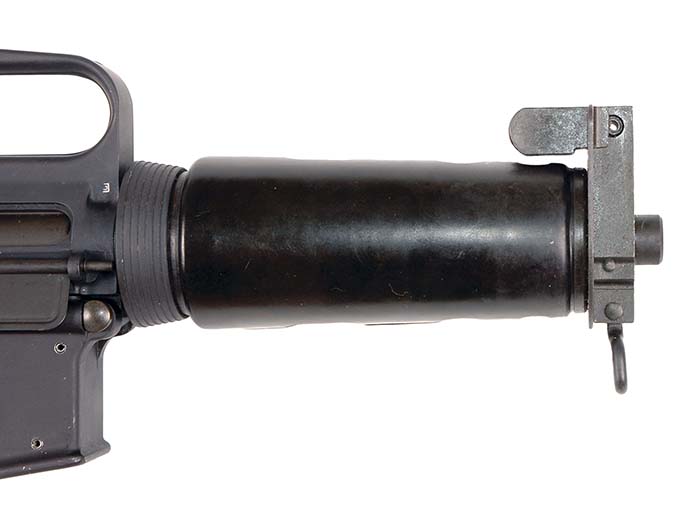
New Manufacture “DOE” Barrel Assembly
For those who missed out on the opportunity to purchase an original 7-inch “DOE” upper, there is good news.
Very accurate, high quality reproduction assemblies are once again available from Liemohn Manufacturing LLC. The company made an initial run of the replica DOE barrel assemblies, but quickly sold out, and now has decided to start a second run. The 1/10 twist barrel is made of 4140 high quality steel, but is not chrome-lined. The barrels are marked in such a way that they cannot be passed off as originals in the future. Like the originals, Liemohn’s standard muzzles are not threaded, but can be threaded upon request in 1/2×36 or 1/2×28. Other threads are available on special order. The threaded barrel option adds approximately 9/16 of an inch to the barrel length. The handguards are made from a resin cast, and more durable than the rather fragile originals. The front sight components are also made from 4140 steel and are machined in house on a Haas CNC milling machine. The components are gray parkerized, and a very close color match to Colt’s finish. The barrel comes complete with the folding front sight assembly, handguards, barrel nut and delta ring. 9mm upper receivers and other 9mm/M16 parts are also available at extra cost. The 7-inch barrel makes the 9mm/M16 a handy, compact weapon.
NOTE: It is a felony to install a barrel with an overall length less than 16-inches on a stocked semiautomatic AR-15 type rifle without approval from the ATF.
Colt produced an AR-15 semiautomatic-only version of the 9mm carbine with a 16-inch barrel in a number of configurations. Colt still lists an updated 9mm carbine in their 2015 brochure as the model AR6951, this carbine has a flat top upper receiver, flip-up rear sight and a 4-position telescoping buttstock.
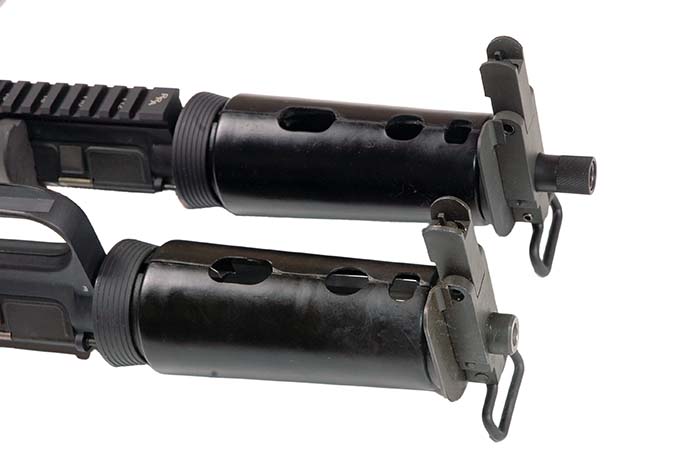
Models R0991, R0992, R6951
Colt still offers their 9mm/M16 submachine gun in their military and law enforcement catalogs. The submachine guns have been updated with a third generation composite collapsible buttstock, flat-top receiver, and handguards featuring a modular rail system for mounting a variety of optics and accessories and a 10.5-inch barrel. There are several models available with a choice of semi-automatic only, semi and full automatic or semi and a 3-round burst.
R6951 Safe-Semi, 16.1” Barrel
R0991 Safe-Semi-Auto, 10.5” Barrel
R0992 Safe-Semi-Burst, 10.5” Barrel
Reproduction DOE barrels and 9mm M16 parts.
Liemohn Manufacturing LLC
http://liemohnmfg.com/
machineguntom4@yahoo.com
Publications:
The Black Rifle II by Chris Bartocci
Available from Chipotle Publishing LLC
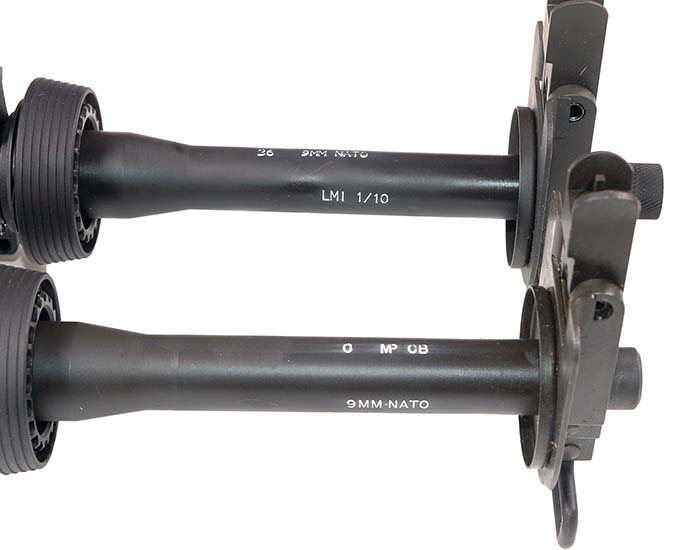


| This article first appeared in Small Arms Review V20N8 (October 2016) |



